Cao Cao › Caracalla › Etruscan Bronze Mirrors » Origins and History
Articles and Definitions › Contents
- Cao Cao › Who Was
- Caracalla › Who Was
- Etruscan Bronze Mirrors › Origins
Ancient civilizations › Historical places, and their characters
Cao Cao › Who Was
Definition and Origins

Cao Cao (c. 155-220 CE) was a military dictator in ancient China during the end of the Han dynasty. Something more than a mere warlord, Cao Cao supported a puppet emperor and governed a large area of northern China. His attempts to unify China ultimately failed, but he did found the large state of Wei and introduced various administrative changes including a new social ranking system and land reforms. Cao Cao's ruthless objective of recapturing the lost glory of the Han empire, his manipulation of the imperial court and association with unsavoury political intrigues have resulted in an ambiguous reputation which has darkened ever since his portrayal as the villain of the popular 14th-century CE epic the Romance of the Three Kingdoms.
EARLY LIFE & FAMILY
The early life and biographical details of Cao Cao are sketchy and disputed, facts being difficult to separate from legend. Cao Cao was born in c. 155 CE, the son of Lady Ding and Cao Song, who was himself the adopted son of Cao Teng, an influential and powerful eunuch at the Han court. The association with the eunuchs, who pulled the strings of imperial politics behind the scenes, was, no doubt, one of the reasons for Cao Cao's meteoric rise. Cao Cao may also have been adopted, possibly from the Xiabou, an aristocratic family group in the Pei district, modern Boxian. Cao Cao had many children of his own, the most famous being his sons Cao Pi and Cao Zhi.
CAO CAO FAMOUSLY PUT DOWN THE YELLOW TURBAN REBELLION IN THE SECOND HALF OF THE 2ND CENTURY CE.
YELLOW TURBAN REBELLION
Cao Cao's first role of note was as Commandant and police chief at Luoyang, the capital, during the 170s CE. He early-on established a reputation for being a stickler with the law and was not afraid to challenge the rich and powerful. He came to wider prominence when he famously put down the Yellow Turban rebellion in the second half of the 2nd century CE. The rebellion was so called because the protagonists wore a turban whose colour represented earth, an element they hoped would put out the fire which was the element selected by the Han. A religious movement, the Yellow Turban cult probably derived from Tibet and was closely associated with Taoism. Its popularity was helped by the promotion of aid to the poor and criticism of the discrimination against women and the lower classes, which was rife in Chinese society. The cult eventually turned into a major military rebellion, which was rather ironic considering its leader Zhang Jue preached the objective of a Great Peace.
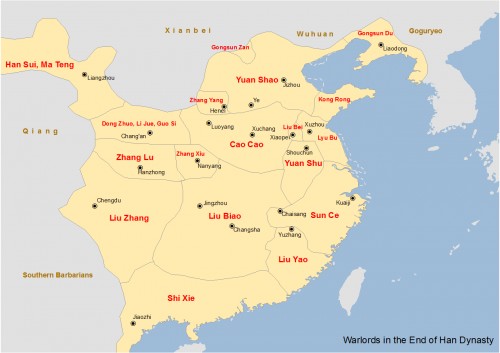
China Warlords, 2nd-3rd century CE.
Strong in eastern China, the rebels, nevertheless, coordinated a series of uprisings across China in 184 CE which attacked the offices of local government. The whole of the country was split into pockets held by rebels, warlords, or regional governors still loyal to the state. The confusion, constant warring, and deprivation of the Chinese people were summarised in a poem attributed to Cao Cao, who, like many leaders of the period, had a serious literary bent.
My armour has been worn so long that lice breed in it,Myriad lineages have perished.White bones exposed in the fields,For a thousand li not even a cock is heard.Only one out of a hundred survives,Thinking of it rends my entrails.(Lewis, 28)
The rebellion was brutally quashed by an army sent by Cao Cao, and Zhang Jue was killed or executed. The movement did rumble on under new leadership in eastern Sichuan province but was finally stamped out in 215 CE, again by a Cao Cao-sent force.
An unfortunate consequence of the rebellion was that several local warlords had been backed to raise their own armies and deal with the Yellow Turbans in their area. When the rebels were dealt with, these armies often clashed with each other and there followed a sustained period of civil war during which Luoyang was sacked in 189 CE.
Cao Cao, after several setbacks, eventually established himself as the powerful governor of Yan province by 196 CE. He made his headquarters at Xu in Yingchuan (Henan province). Cao Cao would eventually become the most powerful of the Chinese warlords, particularly following his victory over rival warlord Yuan Shao at the battle of Guandu in 199-200 CE. Cao Cao took on a series of impressive titles in his role as the most powerful man at court: Marquis, Director of Retainers and then Excellency of Works. By 205 CE he was able to take the reigns of government, with the emperor left in place merely as a token gesture to past tradition. Choosing Ye as his capital, Cao Cao took many of the emperor's previous privileges for himself and adopted the titles of chengxiang or Imperial Chancellor in 208 CE and Duke of Wei in 213 CE. In 216 CE he went a step further and declared himself the King of Wei, as his state was now known. The year before the former warlord had made one of his daughters empress, completing his stranglehold on power.
CAO CAO'S REFORMS
Cao Cao, although having conquered the Yellow River valley, the Wuhuan in the northeast (207 CE), and now holding much of northern China, struggled to control all of the former Han territories. Large areas under the jurisdiction of rival warlords still remained. His attempts to unify a greater area of China met with spectacular failure in the form of a resounding defeat at the battle of Red Cliffs in the Yangtze Valley in 208 CE. Disease and unfamiliarity with both local geography and southern fighting techniques may have combined to frustrate Cao Cao's empire-building ambitions. The victor that day was the young warlord Sun Quan who would later become the emperor of the rival Wu state.
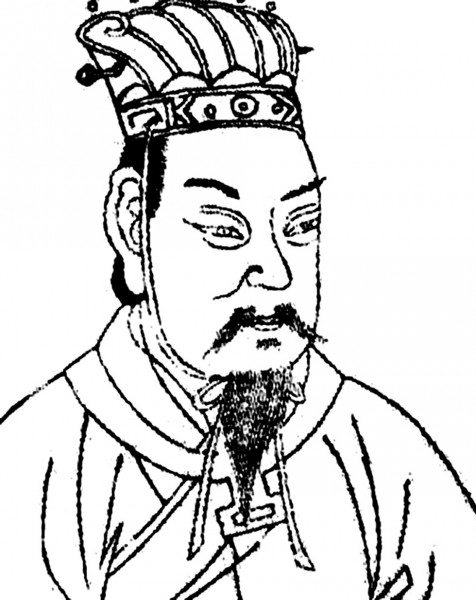
Cao Cao
In order to consolidate the lands he did control, Cao Cao embarked on a series of administrative reforms which were designed to reinforce the centralisation of Chinese government and ensure the tentacles of the state were far-reaching and unchallenged. One of the features of the reforms was to curb excessive state expenditure. For this reason, there were laws passed which, for example, forbade the use of costly jade funerary shrouds.
Other measures included the introduction of a nine-level ranking system for court officials ( jiupin zhongzheng ), a system which lasted right through several later dynasties. This is not to say that there were any significant changes in the recruitment process, though, as Cao Cao continued the tradition of selecting ministers and officials based on who they knew, what their standing was in the local community, and where they came from rather than pure talent. Designed to exploit the official's local contacts and knowledge, the system only ended up favouring those with the right connections who could jump several steps in the nine-rung ladder of promotion.
CAO CAO RESETTLED PEASANTS LEFT HOMELESS ON TO ABANDONED LANDS RECLAIMED BY THE STATE.
Another policy of Cao Cao's was designed to break up traditional regional loyalties and fill up the state coffers. This involved allowing the resettlement of peasants left homeless on to abandoned lands reclaimed by the state after war had ravaged the area. The peasants and defeated rebels similarly resettled became paying tenants and thus a useful source of income for the state without the middleman of a local tax collector.
DEATH & LEGACY
Cao Cao died in 220 CE but his second son, Cao Pi, would go on to outdo his father. Forcing the last Han emperor to abdicate, he then founded the Wei dynasty (221-265 CE). Calling himself Emperor Wen, he also became an accomplished and pioneering poet and literary critic. Cao Cao was, meanwhile, given the posthumous title of Emperor Wu of Wei, but his goal of a unified China would not be realised for another three centuries. The life of Cao Cao was recorded in his own book, Apologia, written in 210-211 CE and one of the earliest autobiographies from ancient China.
Cao Cao's life is also the subject of a celebrated novel from the Ming Dynasty (1368-1644 CE), the Romance of the Three Kingdoms ( Sanguo yanyi ), where he is the deliciously Machiavellian villain of the piece. Operas, too, cast him as a villain, with actors portraying the dictator usually wearing a snarling white mask with sinister eyebrows. More recently, the military leader has become the subject of several popular television series and computer games. Again indicative of the dubious reputation of the dictator, his name lives on in the Chinese expression “Speak of Cao Cao and he appears” which is broadly equivalent to “Speak of the devil” in English.

Tomb of Cao Cao
CAO CAO'S TOMB
Interest in Cao Cao was further piqued in 2008 CE by Chinese archaeologists claiming they had discovered his tomb.Excavated near Xigaoxue in Henan province, the tomb consists of two main chambers connected by an arched doorway and covers 750 square metres (8,000 square feet). Unfortunately, the tomb had already been looted and its connection with Cao Cao has been difficult to ascertain with certainty. The tentative link is based on three stones inscribed with “Wu of Wei”, one discovered some distance from the tomb itself, one which may have been removed from the tomb, and a third found by archaeologists in the tomb itself and describing several bronze weapons as belonging to Wu of Wei. However, the absence of corroborating evidence, coupled with past cases of the Chinese state making similar premature claims for important historical figures, has led to archaeologists and historians outside China (and some academics inside it) to dispute the claim that it is the dictator's tomb. The tomb does seem to belong to the right place and period, and an important person was certainly interred there. Time and further study may well tell if the tomb at Xigaoxue is indeed the final resting place of Cao Cao, one of ancient China's most enigmatic figures.
Caracalla › Who Was
Definition and Origins
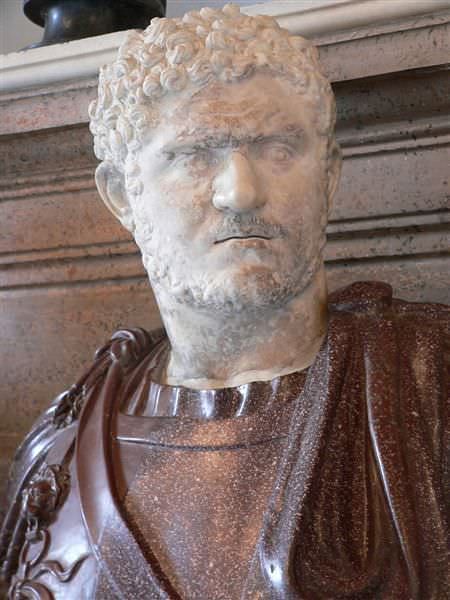
Emperor Caracalla was born Lucius Septimius Bassianus on the 4th of April 188 CE in Lugdunum (Lyon) where his father Septimius Severus was serving as the governor of Gallia Lugdunensis during the last years of the Emperor Commodus.When Caracalla was seven, his name was changed to Marcus Aurelius Antoninus. This was done because of the wish of his father, now emperor, to link the new Severan dynasty with the previous Antonine one. The name 'Caracalla' was considered a nickname and referred to a type of cloak that the emperor wore (the nickname was originally used pejoratively and was never an official name of the emperor). At the time his name was changed, Caracalla became the official heir of his father, and in 198 CE at the age of ten, he was designated co-ruler with Severus (albeit a very junior co-ruler!).
CARACALLA'S EARLY LIFE
From an early age, Caracalla was constantly in conflict with his brother Geta who was only 11 months younger than he. At the age of 14, Caracalla was married to the daughter of Severus' close friend Plautianus, Fulvia Plautilla, but this arranged marriage was not a happy one, and Caracalla despised his new wife (Dio 77.3.1 states that she was a 'shameless creature').While the marriage produced a single daughter, it came to an abrupt end when in 205 CE Plautianus was accused and convicted of treason and executed. Plautilla was exiled and later put to death upon Caracalla's accession (Dio 77.5.3).
CARACALLA WAS CRUEL, CAPRICIOUS, MURDEROUS, WILFULLY UNCOUTH, AND WAS LACKING IN ANY SORT OF FILIAL LOYALTY.
In the year 208 CE, Septimius Severus, upon hearing of troubles in Britain, thought it a good opportunity to not only campaign there but to take both of his sons with him as they were living libertine lifestyles in the city of Rome. Campaigning, Severus thought, would give both boys exposure to the realities of rule, thus providing experience for them which they could use upon succeeding their father. While in Britain, Geta was supposedly put in charge of civil administration there, while Caracalla and his father campaigned in Scotland. Although Caracalla did acquire some valuable experience in military matters, he seems to have revealed an even darker side of his personality, and according to Dio, tried on at least one occasion to kill his father so that he could become emperor. Although it was unsuccessful, Severus admonished his son, leaving a sword within his son's reach challenging him to finish the job that he botched earlier (Dio 77.14.1-7). Caracalla backed down, but according to Herodian, was constantly trying to convince Severus' doctors to hasten the dying emperor's demise (3.15.2).In any case, the emperor died at Ebaracum in February 211 CE. Severus' last advice to both Caracalla and Geta was to 'Be good to each other, enrich the army, and damn the rest' (Dio 77.15.2).
CARACALLA BECOMES EMPEROR
In 211 CE Caracalla became emperor along with his younger brother Geta. The relationship between the two did not resemble the loving one of Marcus Aurelius and Lucius Verus fifty years earlier, and it seems that both brothers were constantly conspiring against each other so that one of them could become sole emperor. When the two did try to make decisions together, they constantly bickered, disagreeing on everything from political appointments to legal decisions. Indeed, according to Herodian, things got so bad between the two brothers that not only did they divide the imperial palace between themselves but also tried to convince each other's cooks to drop poison into the other's food, it was also proposed that the empire be divided up between the two into eastern and western parts. It was only the intervention of the boys' mother, Julia Domna, that this plan was not realized (Herodian 4.3.4-9).
Nevertheless, Caracalla resolved to be rid of his brother. After a failed attempt to assassinate his brother on the Saturnalia(Dio 78.2), Caracalla arranged a meeting with his brother and mother in the imperial apartments, ostensibly to reconcile.Instead, upon appearing in his brother's room with centurions, Caracalla had his men murder Geta who tried to hide in his mother's arms. Despite her shock and sorrow, Caracalla forbade his mother from even shedding tears over Geta (ibid.; Herodian 4.4). So by 212 CE, Caracalla was sole emperor, and according to Dio, his brother's murder was followed by a purge of Geta's followers totalling roughly 20,000 deaths, including that of the former Praetorian Prefect Cilo and the jurist Papinian (Dio 78.3-6). Caracalla, when explaining his actions to the Senate, asserted that he was defending himself from Geta and rejected the idea that the concept of two emperors ruling the empire could work, declaring that
...you must lay aside your differences of opinion in thought and in attitude and lead your lives in security, looking to one emperor alone. Jupiter, as he is himself sole ruler of the gods, thus gives to one ruler sole charge of mankind.
The Senate could do nothing but tremble before his words (Herodian 4.5).
Geta was duly damned from memory ( damnatio memoriae ), and all references to him in public were erased; it was considered a crime to mention his name.

Young Caracalla
CARACALLA & THE ROMAN ARMY IN THE WEST
While Caracalla did not take his father's advice in being good to his brother, he certainly took to heart that he needed to keep the army happy. Indeed, Caracalla declared to his soldiers that:
I am one of you," he said, "and it is because of you alone that I care to live, in order that I may confer upon you many favours; for all the treasuries are yours." And he further said: "I pray to live with you, if possible, but if not, at any rate to die with you. For I do not fear death in any form, and it is my desire to end my days in warfare.There should a man die, or nowhere. (Dio 78.3.2).
He backed up his words with actions by raising annual army pay, evidently by 50% (Herodian 4.4.7). In order to pay for this raise, Caracalla debased the coinage from a silver content of from about 58 to 50 percent. It should be noted, however, that while he did debase the coinage, this did not cause deflation, as those receiving the coin were willing to accept its basic value.Caracalla also created a new coin known as the antoninianus which was supposed to be worth 2 denarii to help pay for these army raises (although the actual silver content was only worth 1.5 denarii ; Birley 1996, 221). [editor note: There has been a great debate over the years as to whether debasement of the coinage directly led to inflation. The more traditionalist school argues that debasement caused price inflation which began in the Severan era (For example, see Jones 1974; Greene 1985, 57-66; Burnett 1987, 122-131). A more 'moderate' school states that the debasements of Severus and Caracalla did not cause inflation; however, because of the precedent set by the Severans to debase, this became a regular practice of successive emperors when they needed coin, and that consequently inflation set in during the reign of Gordian III (Crawford 1975, 566-71; Potter 1990). A third school of thought states that there is no evidence that inflation occurred at all in the third century as a result of debasement as the empire was not fully monetized, especially in the frontier areas,and this extra coinage was merely absorbed into these non-monetized areas. Indeed, as long as those using the money were willing to accept the face value of the coinage, there would not be debasement-caused inflation. When inflation did occur, it usually was as a result of whenever an emperor such as Aurelian or Diocletian tried to reform the currency which caused a temporary loss of confidence in the coinage and caused prices to fluctuate wildly in the short term (see Rathbone 1996, 321-40). This debate has been continuous and shows no signs of being resolved any time soon.]
Moreover, he attempted to portray himself as a fellow soldier while on campaign, sharing in the army's labours, personally carrying legionary standards and even grinding his own flour and baking his own bread, as all Roman soldiers did. These actions made him wildly popular with the army.
During this time, military activity in Britain began to wind down. As the campaign in Britain had stalled by the end of Severus' reign, Caracalla thought it necessary to engage in a face-saving maneuver and end the campaign there, but not before essentially creating a protectorate in southern Scotland to keep an eye on native activities. This essentially not only ensured his father's legacy as a propagator imperii on the island but also would justify Caracalla's adoption of the title Britannicus (Birley 1988, 180). Even so, the natives north of Hadrian ’s Wall and the 'protectorate' had probably by this time felt discretion to be the better part of valour as making trouble had only invited the Roman army into their lands. If this is the case, then the Severan campaigns in Scotland kept that area peaceful for the better part of a century (Breeze and Dobson 2000, 152). There is also a degree of debate over whether it was Severus or in fact Caracalla who was the one to split Britain into two provinces in order to prevent governors from having access to a large number of legions thus tempting them to make a bid for the imperial throne. [editor note: For example, Mann and Jarrett 1967, 61-4, argue that it was Severus who carried out the division, while Southern 2001, 37, suggests that the division could have been carried out as late as 213.]
Instead, upon leaving Rome in 213 CE, Caracalla (who would spend the rest of his reign in the provinces) decided to campaign in Raetia and Upper Germany against the Alamanni. While it is not clear if these enemies were making trouble for the empire, Caracalla prepared for this campaign very thoroughly and it seems that this campaign may have been a pre-emptive strike or a chance for Caracalla to win military glory in his own right. [ editor note: Southern 2001, 53, stated that in any case Caracalla's campaign may have provided a good opportunity to provide maintenance for the Rhine frontiers. For an important view, see Drinkwater 2007, who argued that the threat posed by the Alamanni during their existence as a federation was fairly minimal but nevertheless always been overstated by Roman emperors, who used this threat as an excuse to campaign against an enemy as a way of building up their military credentials. That is, the Rhine frontier and the wars against the Alamanni were a training ground where emperors could improve their military skills so that they knew how to fight when a more important campaign arose.] In any case, it is important to state that there was no serious enemy activity on this frontier until two decades later, so the emperor may have made an important contribution to Rome's security there, and had legitimate claim to the title of Germanicus which he adopted after these campaigns. Southern writes that Caracalla's frontier policy in this region:
...seems to have been a combination of open warfare and demonstrations of strength, followed by an organisation of the frontiers themselves. He may have paid subsidies to the tribes after his campaigns, and in other cases he stirred up one tribe against another to keep them occupied and their attentions diverted from Roman territory (Southern 2001, 53).
 ROMAN EMPEROR CARACALLA
ROMAN EMPEROR CARACALLA

THE CONSTITUTIO ANTONINIANA
One of the most noteworthy (and debated) acts of Caracalla's reign is his Edict of 212 CE (the Constitutio Antoniniana ) which awarded Roman citizenship to all free inhabitants of the empire. The motives for this action are many. Propagandistically, this edict allowed Caracalla to portray himself as a more egalitarian emperor who believed that all free people of the empire should be citizens, thus creating a stronger sense of Roman identity among them (Southern 2001, 51-2; Potter 2004, 138-9). More practically, however, this edict meant that Caracalla could widen the base from which he could collect an increased inheritance tax (ibid). Indeed, Dio states that, as a result of the money he lavished on the army, a financial shortfall was created and the emperor needed money, thus necessitating this edict and the consequent cheapening of the citizenship. [ editor note: Dio 79.9.5. In discussing this edict, Dio described how Caracalla was able to create a larger tax base while at the same time raising taxes to 5 percent on the manumission of slaves and 10 percent on inheritances.] Moreover, the propaganda of equality was illusory, as instead of a hierarchy of citizens and non-citizens in the empire, the edict created a new class division of upper and lower classes ( honestiores and humiliores ) in which honestiores had greater legal rights and privileges, while humilioreshad less legal protection and were subject to harsher punishments (Southern 2001, 52).
CARACALLA IN THE EAST
Simply put, Caracalla idolized Alexander the Great and sought to emulate him (Dio 78.7-8). Consequently, he saw fit to campaign in the east as a way to accomplish such emulation. It is debatable whether or not such campaigns were necessary, as at this time Rome's major rival, the Parthian Empire, was involved in internal conflicts, and the Parthian Royal House was fighting among itself (Dio 78.12.2-3). Caracalla saw this, however, as an excuse to mount a campaign to make gains at the expense of the Parthians. He returned to Rome after his activities in Germany, summoned Abgar, the King of Edessa, to the city and imprisoned him in the hopes of turning Edessa into a colony and use it as a base from which to launch an invasion of Parthia. He seems to have tried to have done the same with the king of Armenia but encountered resistance from that land's population (Dio 78.12.1). When he arrived in the East in 215 CE, Caracalla had little reason to justify an invasion of Parthia, as that empire's king, Vologaeses V, made a point to avoid any action that could be construed as a provocation. Leaving preparations for a campaign against Parthia to his general Theocritus, Caracalla visited Alexandria, ostensibly to pay respects to Alexander the Great at his tomb. He was first welcomed by the Alexandrians, but when he found out they were making jokes about the reasons he gave for the murder of his brother Geta, flew into a rage and had a large segment of the population massacred (Dio 78.2.2; Herodian 4.9.8).
Caracalla then moved east to the frontier in 216 CE and found that the situation was not as advantageous to Rome as it was previously. Vologaeses' brother Artabanus V had succeeded him, and managed to reinstate a degree of stability to Parthia.Caracalla's best option in this instance would have been a quick campaign to demonstrate Roman strength, but instead the emperor opted to offer his own hand in marriage to one of Artabanus' daughters. Artabanus' refused, seeing this as a rather lame attempt by Caracalla to lay claim to Parthia (Herodian 4.10.4-5; Dio 79.1). According to Herodian, Caracalla's behaviour was even more reprehensible: the emperor invited Artabanus and his household to meet to discuss a permanent peace. Upon meeting with the Parthian king and his retinue, who had put aside their weapons as a sign of good will, Caracalla ordered his forces to massacre them. Most of the Parthians present were killed, but Artabanus was able to escape with a few companions (Herodian 4.11.1-6).
Caracalla then campaigned in Media in 217 CE and was planning a further campaign when his treacherous and rash behaviour caught up with him. It seems that he made sport of ridiculing his Praetorian Prefect M. Opellius Macrinus, who had a great deal of experience in legal matters but next to none in affairs militarily (Herodian 4.12.1-3). Macrinus began to resent this, but Caracalla began to fear the man, especially after hearing of a prophecy that Macrinus would become emperor.Caracalla then began to move against his Prefect, but Macrinus got wind of this and, realizing he was in great danger, conspired to assassinate the emperor (Dio 79.4.1-2; Herodian 4.12.5). This he did on the road to Carrhae when the emperor stopped his troops on the side of the road to relieve himself. Evidently, while Caracalla was in the midst of urinating, one of Macrinus' men fell upon him, ending the emperor's life (Dio 79.5; 4.13.1-5). Caracalla was 29 years old when he died. When the bulk of the army had heard of his end, they were enraged at the murder of the emperor whom they loved. Indeed, Macrinus' inability to placate the soldiers helped to play a part in his own demise when his enemies offered Caracalla's cousin Elagabalus as Emperor in 218 CE.
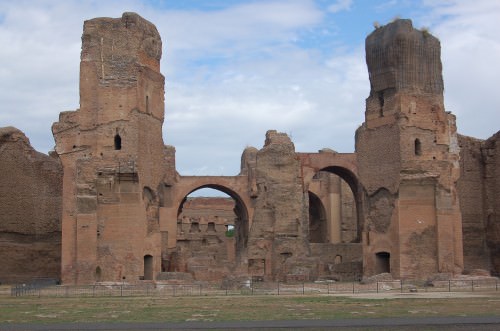
Terme di Caracalla
ASSESSMENT
Caracalla was one of the most unattractive individuals ever to become emperor of Rome. He was cruel, capricious, murderous, wilfully uncouth, and was lacking in any sort of filial loyalty save for that of his mother Julia Domna (who died shortly after his assassination) [editor note:Dio 79.23 states that Julia Domna, possibly suffering from breast cancer and despairing at the death of her son, took her own life.]. This is certainly the picture given to us by both Dio and Herodian. While some of the information in these accounts might be embellished, they nevertheless shed light on the increasing trend of emperors depending more on the army, believing they could act in any way they wanted towards the rest of the population provided they keep the soldiers happy. This is not entirely the fault of Caracalla, as he was following the advice of his father and genuinely wanted to be seen as a soldier and conqueror in the vein of Alexander the Great rather than the 'philosopher king' that Marcus Aurelius embodied. While his military policies in the western empire may have contributed to that region's security for several years, his eastern policy was self-destructive and unnecessary. Had Caracalla followed the formula of Augustus and maintained a balance between keeping both the army and the upper echelons of Roman society happy, he may have been more successful. In any case, the third century would witness many emperors who took the tact that Caracalla had and would overly depend on the support of the army for their regime at their own peril.
Etruscan Bronze Mirrors › Origins
Ancient Civilizations
The Etruscan civilization flourished in central Italy between the 8th and 3rd century BCE and produced distinctive art in the form of decorated pottery, figure sculpture, wall paintings, and the focus of this article, engraved bronze mirrors. Perhaps rather unfairly, the Etruscans long-held a reputation for effeminacy and as lovers of luxury; a portrait not coincidentally perpetuated by their conquerors the Romans. The high number of Etruscan -made bronze mirrors found in their tombs and elsewhere only fuelled this reputation as the ancient Mediterranean's great narcissists.
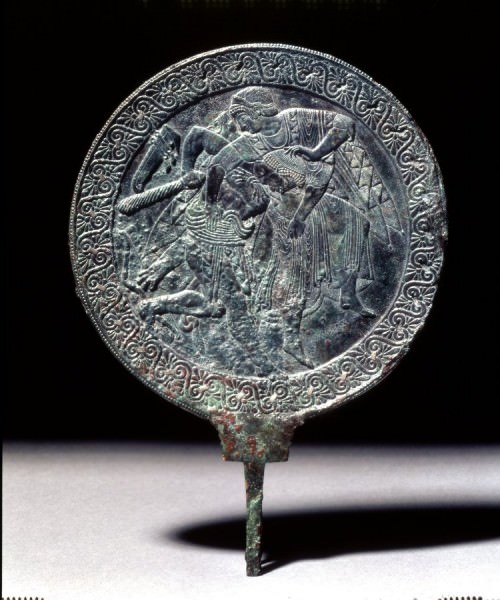
Etruscan Bronze Mirror Showing Hercules
FUNCTION
Mirrors, known to the Etruscans as malena or malstria, were first produced in quantity from the end of the 6th century BCE right through to the 2nd century BCE. They were locally made in such Etruscan towns as Vulci, Tarquinia, Cerveteri and Chiusi, as attested by the large number of finds in those places.
BESIDES BEING AN OBJECT OF PRACTICAL DAILY USE, MIRRORS WERE A STATUS SYMBOL FOR ARISTOCRATIC ETRUSCAN WOMEN.
Besides being an object of practical daily use, mirrors were a status symbol for aristocratic Etruscan women and appear on Etruscan tomb wall paintings often carried by a lady's maidservant. There is evidence, too, that they were used by some men if the fact that they were found in male-only tombs is an indicator. Mirrors were commonly given as part of a bride's dowry, and it is likely that these valuable objects, frequently decorated with great craftsmanship, also acquired a sentimental value. Mirrors have survived in such great numbers (over 3,000) because they were commonly laid with the deceased in Etruscan tombs, perhaps precisely because they were one of the objects the person had used daily throughout their lives. Curiously, many mirrors so placed in tombs have had their reflective surface made useless by the addition of an inscription: suthina, meaning 'of the grave.'
DESIGN
Etruscan bronze mirrors, like Greek ones, were designed to be held in the hand using a single handle. The reflective side of mirrors was made by highly polishing or silvering the surface. From the 3rd century BCE more tin was used in the bronze alloy, which meant that the reflective surface gave a clearer image and was less prone to scratching and corrosion. Some mirrors from the 4th century BCE onwards were protected by a concave cover attached by a single hinge. The inside of the lid was often polished to reflect extra light onto the face of the user while the outside carried cut-out reliefs filled with a lead backing. A third type of mirror has the round reflective surface set into the lid of a wooden box.
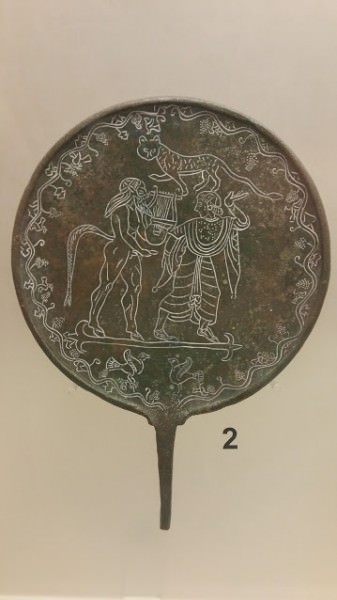
Etruscan Bronze Mirror with Nymph & Silenus
The flat reverse side of bronze mirrors, if not left plain (half the surviving examples are so), was an ideal canvas for engraved decoration, inscription, or even carved shallow relief. The latter decoration technique is even more rarely inlaid with silver, as in an example now in the British Museum, London.
Handles were formed by casting the mirror with a tang at the bottom. This could then be inserted into a handle made from wood, bone, or ivory, but few such perishable pieces have survived intact. Some handles were painted or had carved relief scenes. Another type of mirror was produced from the 4th century BCE which had the handle cast along with the body. Many of this latter type have a bronze ram or hind's head decorating the end of the handle.
DECORATION
The main purpose of Etruscan mirror decoration would seem to be just that, decoration. However, these valuable objects might also have become symbolic transfers of wealth and family ties, for example, when the bride and groom were from different clans. In the latter case, the decoration may have represented, either directly or metaphorically, the union of the heritage of two families. Scenes and the people in them are often helpfully identified by accompanying inscriptions around the mirror edge, and these sometimes even describe the owner, for example, 'I am the mirror of Larthi Puruhena' ( Mi malena larthia puruhenas) or even the giver, 'Tite Cale to his mother gave this mirror as a gift' ( tite cale : atial : turce malstria : cver ). Around 300 mirrors have names inscribed on them, most being female, and so they are an important indicator of literacy amongst Etruscan women.
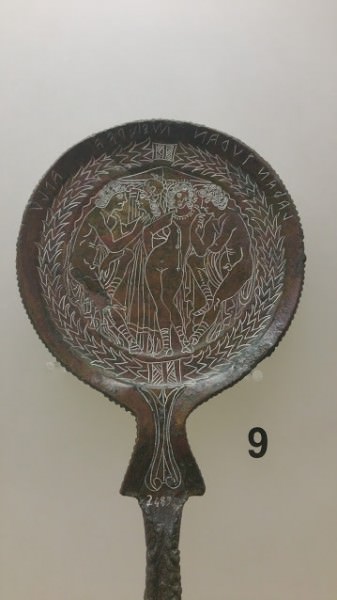
Etruscan Bronze Mirror
Some mirrors have scenes of wedding preparations, couples embracing or a lady in the process of dressing, but the most common subject for mirror decoration was mythology. Here mirrors illustrate the great influence of Greek culture on the Etruscans as the myths are, invariably, of Greek origin, even if they are sometimes given an Etruscan twist. Scenes are often framed by a border of twisted ivy, vine, myrtle, or laurel leaves.
Perhaps not surprisingly, myths which involved a degree of vanity or gods renowned for their physical beauty are particularly popular subjects. Thus we see scenes of Paris deciding which of the three goddesses are the most beautiful and plumbing for Aphrodite (for the Etruscans: Turan) ahead of Athena and Hera. Aphrodite, the goddess of love and beauty being attended to and beautified by her entourage is another common subject. The impossibly handsome Adonis (Atune) and favourite of Aphrodite, Zeus carrying off the attractive youth Ganymede (Catamite), Eos – the winged Dawn known for her love of handsome hunters, and that most famous earthly beauty of all – Helen of Troy, are all personas bound to inspire those who managed to pull themselves from the mirror's reflective side.
LICENSE
Article based on information obtained from these sources:with permission from the Website Ancient History Encyclopedia
Content is available under License Creative Commons: Attribution-NonCommercial-ShareAlike 3.0 Unported. CC-BY-NC-SA License